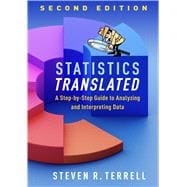Roping the reader in with humor and real-world case examples presented as mysteries to be solved, this engaging text has been updated with new cases, the latest version of SPSS, and new coverage of multivariate analysis of variance. Steven R. Terrell prepares students and practitioners to become informed consumers of statistics so that they can make decisions based on data, and understand decisions others have made. He identifies six simple steps and guides readers to master them--from identifying a researchable problem to stating a hypothesis; identifying independent and dependent variables; and selecting, computing, and interpreting appropriate statistical tests. All techniques are demonstrated both manually and with the help of SPSS software.
New to This Edition
*All software instructions and examples are updated to SPSS Version 25.
*Expanded chapter on the analysis of variance (ANOVA)--now covers multivariate ANOVA.
*New and revised examples and quiz items pertaining to a broader range of fields, such as business, information systems, and medical sciences, along with education and psychology.
Pedagogical Features
*Examples of SPSS screenshots used for analyzing data.
*User-friendly cautionary notes, "Putting it All Together" recaps, and alerts, such as "notice the effect size" or "check the direction of the mean scores."
*End-of-chapter "Quiz Time" exercises that guide students to answer intriguing questions like whether working from home increases productivity, or whether age affects how long it takes to complete a doctoral degree.
*Lists of key terms and formulas in each chapter, plus end-of-book glossary.








